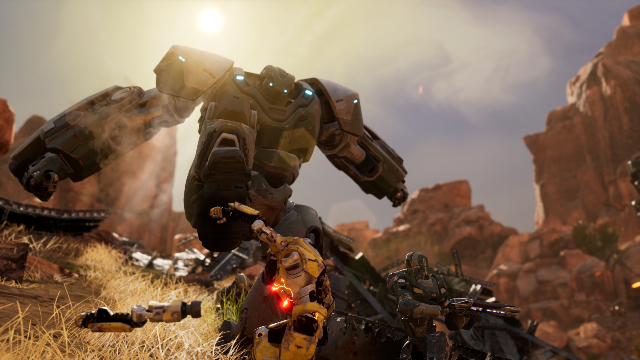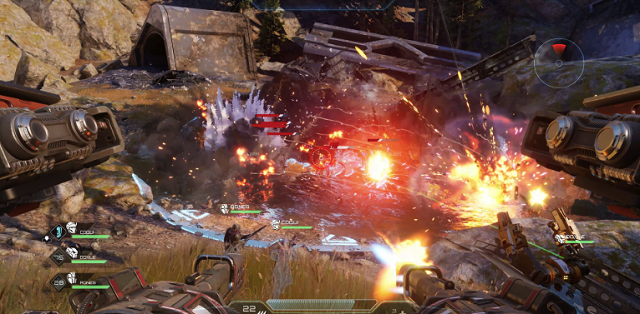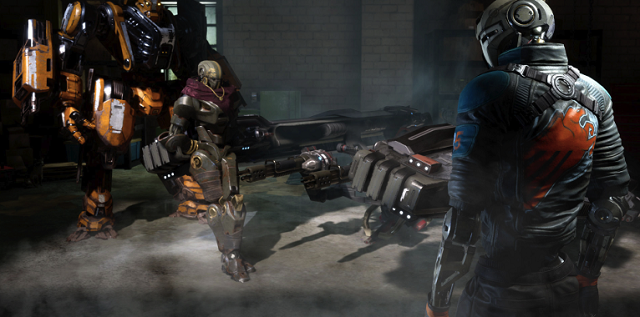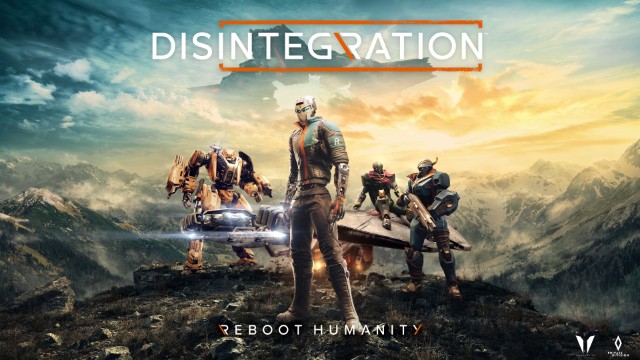In the years that followed Halo — the era which ensured Sony and Nintendo would have to contend with a new player on the field — various companies tried to find their “Halo Killer,” that elusive new shooter that would outshine Bungie’s sparkling new IP.
Many tried, most failed. Some, like a sci-fi shooter under Activision that was later folded into Call of Duty 4, never even saw the light of day. These days, the shooter space is so healthy no one is really seeking to kill Halo. They just live in peace alongside it.
We’ve seen several routes taken to this happy ending, in the form of battle royales, hero shooters, and other new spins on the genre. Led by the co-creator of Halo himself, Disintegration proves there’s still room to innovate.
Disintegration Review in Progress: Genre Cyborgs from the Future

Disintegration is the debut game from V1 Interactive, the 30-person indie unit led by Marcus Lehto, who once helped birth one of the shooter genre’s biggest franchises of all-time. Disintegration doesn’t seem to have such lofty expectations, and that’s probably for the best, as its hybrid blending of first-person shooter and real-time strategy mechanics isn’t as inviting as the point-and-shoot project players are used to, but then that’s what makes it so interesting.
Disintegration takes place in a future where humans have almost uniformly moved into mechanical bodies through a process called integration. Unlike some sci-fi stories where our consciousness is uploaded via some computer program, integration demands users literally move their brains into a metal compartment, jokingly called a “brain-can.”
Doing this solves human problems like disease and aging, but not everyone is along for the ride. Disintegration starts fast, where our hero, Romer Shoal, defies the leader of the anti-humanist robots that seek to wipe out the last Naturals (non-integrated humans) and their sympathizers.
What follows is a sci-fi action story which, while enjoyable in a Marvel movie sort of way, never really touches on the fascinating backdrop it’s set to. Disintegration is desperate for a tie-in comic at the very least, and though that wouldn’t make the game directly any better, it would be more satisfying to someone like me. I was eager to see these concepts explored but instead, I was left to a ragtag group of robo-heroes who crack jokes and save the world like the Avengers.

It’s not that they’re unlikeable. Romer and his allies are physically and mentally diverse, and the game at least does a great job of reminding me that these are humans still, just more metallic in appearance these days. Often, I found myself going off-script and asking questions the game had no interest answering — things like the how-to behind integration — but also the philosophical questions like, “Do we remain intact as individuals if merely our brains are salvaged?”
These questions feel like the kind that got the world-builders at V1 Interactive excited, but they never become the focus of the game.
At least where the story falters, the gameplay shines. As Disintegration feels like it will live or die on its multiplayer merits, I wasn’t sure if it was safe to expect a fully-fledged single-player campaign, but after eight hours of tactical shooting gameplay, it definitely delivers.
Disintegration is presented 10 meters above the ground in a “gravcycle,” a flying, weaponized mech which seems to have once been used for sport, but it has now become the literal and figurative vehicle of the resistance. As Romer Shoal, players can engage in first-person shooting and real-time squad commands simultaneously.
Cover is enjoyably destructible and enemies are varied enough that the game gets rewardingly tough often, and on higher difficulties, it feels like a true chess match. Even on easy, you’ll need to know when to play like a shooter and when to approach Disintegration like the overseer you always are in your gravcycle. In all cases, it’s most satisfying to be both anyway.
This hovering POV leaves enemies and allies looking ant-like at times, which is a style that won’t excite players just here to shoot stuff, but anyone who enjoys both genres of this crossbreed is going to love Disintegration. A tactical approach is always needed and anyone who spams their squad abilities and hovers around like a drone operated by a five-year-old is going to hit the fail screen often.

In turn, it’s exciting when you roll into a warzone with your unit and lead them to victory, not just by pointing where to go, but by taking on enemies yourself too. Managing cooldowns and knowing how to keep your allies out of the worst possible situations, or instead allowing them to shine with tactical efficiency, only gets more rewarding as enemies and situations get more challenging.
With 12 levels and dozens of challenges to chase throughout, the campaign has a great sense of variety. It often pushes you into particular gameplay styles by suiting you with different gravcycles. All the while, it moves through a variety of aesthetics, like forests, cities, and snowy mountains. At each stop, the juxtaposition of super-advanced human-robot hybrids and the starkly empty world humans once inhabited is hard to miss.
The campaign’s variety in gameplay style, squad loadouts, and setting are all meant to serve as introductions to the online multiplayer suite. In that, there are three game modes to play, and all of them will be somewhat familiar to fans of almost any PvP mode.
Collector is like Kill Confirmed, where deathmatch points only count if you pick up the enemies’ brain-cans. Zone Control is Domination, where two teams fight over three regions across the map. Retrieval is the game’s best mode, and it’s the most unique. With shades of Capture the Flag meets Search and Destroy, players control their units and fend off enemy gravcycles and troops to deliver cores and outlast the opposition.

Each mode is fun, even as the maps feel somewhat lacking in variety at launch. However, Retrieval best highlights the unique playstyle of Disintegration. While the other two modes can devolve into typical shooters with an unskilled lobby, in Retrieval, RTS elements are forced upon players in a good way, demanding everyone use their troop units smartly or get beaten in a hurry. This is the game mode I first played at PAX, and it’s no wonder why. It’s the exemplar of Disintegration‘s promise.
In most rounds, I saw too many players just looking to shoot at other gravcycles. That’s not just a bad idea given the long time-to-kill; it’s a boring strategy. Disintegration isn’t an FPS, at least not solely, so whether you have teammates who know how to play the other modes or you’re playing Retrieval, this hybrid strategy shooter is most enjoyable when you’re pulling from both genres as intended. When that’s not happening, it is only fun so long as you’re on the team that knows what it’s doing.
Teams can be comprised of several different squads, making each one like a hero in Overwatch. They have unique stats and cosmetics to unlock that let you customize teams of Sweet Tooth-like clowns, 1980’s club-goers, and samurai robots among others. It’s over the top in a way that even the Marvel-esque story doesn’t approach, and it’s better for it.
Again, your fun can depend on how well your team balances these playable squads, as just like in a hero shooter, you want to hide your team’s weaknesses and maximize its strengths. If everyone runs in guns-blazing, it’s likely you’ll suffer swift defeat. At launch, too many aren’t getting the message.
Disintegration Review — The Bottom Line

Pros
- Core multiplayer tenets are promising
- Campaign is visually diverse and fun in a Marvel-movie way
- Hero elements in multiplayer make for rewarding playstyle nuances
Cons
- Story never grapples with its interesting backdrop
- Extremely reliant on an attuned multiplayer community
More than most games, Disintegration will live and die according to its community’s ability to learn the ropes. It’s not that either genre the game blends is a conundrum on its own, but the blending of the two may make fans of either favor one side over the other. This is especially disastrous for shooter fans that don’t incorporate the game’s RTS elements.
Thus, it’s a weird task to score a game based on the behaviors of its community, but I feel it’s unavoidable. The story is fun but never dives beneath the surface of its fascinating sci-fi concepts. The multiplayer is what you should want to buy Disintegration for, and I’m hoping its playerbase can filter out the people looking for a new Halo. This isn’t Halo, and it’s better for it. Disintegration has some errors in its code, but this is a robot with its values properly aligned.
[Note: A copy of Disintegration was provided by Private Division for the purpose of this review in progress.]







Published: Jun 9, 2020 11:58 pm